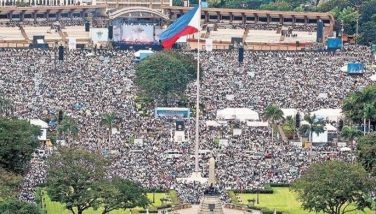Great expectations in store for agriculture sector
August 15, 2004 | 12:00am
Agriculture growth achieved in the first quarter will be sustained throughout the year especially in the grains sector, but the surge in fuel prices, rising cost of imported inputs and a strained government budget could cloud expected advances.
In two papers presented at the 2004 Mid-year Business Economic Briefing of the University of Asia and the Pacific, Rolando Dy, executive director of the UA&P’s Center for Food and Agri Business, expressed confidence in the Department of Agriculture’s (DA) thrusts and programs. Dy presented his findings in "Agriculture: The Next Agenda," and "Food and Agriculture After the Elections," two papers with the theme "The First 180 Days of the President Elect: Great Expectations."
He said the record-breaking 7.7-percent growth in the first quarter bolsters hopes of achieving this year’s projected growth target of four percent. The UA&P projection is even rosier at four to five percent.
Dy said however, that the DA has to address pressing concerns hounding the agriculture sector. One is the dwindling budgetary support that will hamper the implementation of critical interventions. Dy pointed out that while the Agriculture and Fisheries Modernization Act (AFMA) provided for an additional budget for the DA of P15 billion to P20 billion a year starting 1999, this did not materialize.
Congress appropriated only P15.4 billion for the DA in 2004. This is 26 percent lower than the proposed budget of P20.9 billion. This year’s budget is also 35 percent lower than what the AFMA provides for, and eight percent lower than the 2003 allocation. It is also the DA’s lowest budget in real terms if one takes into account inflation. Last year, the DA budget (including AFMA) was only P16.8 billion, 60 percent of which were allotted for personnel services and maintenance and operating expenses.
Dy said the DA also has to address concerns of farm producers about rising production inputs, especially the livestock and poultry growers which have been reeling from the increasing cost of feedmeal ingredients such as corn, soybean and cornmeal substitutes such as wheat. As a result, retail prices of chicken and pork have been escalating since the start of the year.
These concerns are further aggravated by the soaring crude prices in the world market that has made it more expensive to bring imported raw materials for farm production into the country. On the other hand, traders pass on the cost of additional transportation expense to consumers.
The other issues that require attention are the DA’s huge bureaucracy; the lack of continuity, as shown by the change in secretary every two years; devolution of authority from the central to the local governments, which affects extension services to small farmers; lopsided priorities in investments, generally in favor of rice to the neglect of other products; inadequate research and development funds (0.5 percent of agricultural production value); and production targeting without regard for markets and competitiveness.
Dy proposed an 11-point agenda for the DA which primarily calls for the incoming secretary to build on existing initiatives on commodity road maps and supply chain management, which are private sector driven and market led. He also advised the development of an advocacy program for sustainable AFMA implementation based on sound budgeting and economic merits to Congress and other stakeholders.
He also suggested the drawing of a global trade map, including market access advocacies under the World Trade Organization, market niching, competitive intelligence and economic diplomacy. Moreover, he called for the formulation of a human-resource roadmap which covers management education and training.
His other prescriptions include: allowing stakeholders to have a major voice in determining priority agriculture, fishery and rural infrastructure projects, the quality of which should be strictly monitored; a review of the Local Government Code to improve the delivery of agricultural support services to farmers; increasing research and development budget to at least one percent of agricultural value in the next six years; reducing of government staff that would enable government to use savings to increase public investments and the salaries of middle and executive levels at the DA.
In two papers presented at the 2004 Mid-year Business Economic Briefing of the University of Asia and the Pacific, Rolando Dy, executive director of the UA&P’s Center for Food and Agri Business, expressed confidence in the Department of Agriculture’s (DA) thrusts and programs. Dy presented his findings in "Agriculture: The Next Agenda," and "Food and Agriculture After the Elections," two papers with the theme "The First 180 Days of the President Elect: Great Expectations."
He said the record-breaking 7.7-percent growth in the first quarter bolsters hopes of achieving this year’s projected growth target of four percent. The UA&P projection is even rosier at four to five percent.
Dy said however, that the DA has to address pressing concerns hounding the agriculture sector. One is the dwindling budgetary support that will hamper the implementation of critical interventions. Dy pointed out that while the Agriculture and Fisheries Modernization Act (AFMA) provided for an additional budget for the DA of P15 billion to P20 billion a year starting 1999, this did not materialize.
Congress appropriated only P15.4 billion for the DA in 2004. This is 26 percent lower than the proposed budget of P20.9 billion. This year’s budget is also 35 percent lower than what the AFMA provides for, and eight percent lower than the 2003 allocation. It is also the DA’s lowest budget in real terms if one takes into account inflation. Last year, the DA budget (including AFMA) was only P16.8 billion, 60 percent of which were allotted for personnel services and maintenance and operating expenses.
Dy said the DA also has to address concerns of farm producers about rising production inputs, especially the livestock and poultry growers which have been reeling from the increasing cost of feedmeal ingredients such as corn, soybean and cornmeal substitutes such as wheat. As a result, retail prices of chicken and pork have been escalating since the start of the year.
These concerns are further aggravated by the soaring crude prices in the world market that has made it more expensive to bring imported raw materials for farm production into the country. On the other hand, traders pass on the cost of additional transportation expense to consumers.
The other issues that require attention are the DA’s huge bureaucracy; the lack of continuity, as shown by the change in secretary every two years; devolution of authority from the central to the local governments, which affects extension services to small farmers; lopsided priorities in investments, generally in favor of rice to the neglect of other products; inadequate research and development funds (0.5 percent of agricultural production value); and production targeting without regard for markets and competitiveness.
Dy proposed an 11-point agenda for the DA which primarily calls for the incoming secretary to build on existing initiatives on commodity road maps and supply chain management, which are private sector driven and market led. He also advised the development of an advocacy program for sustainable AFMA implementation based on sound budgeting and economic merits to Congress and other stakeholders.
He also suggested the drawing of a global trade map, including market access advocacies under the World Trade Organization, market niching, competitive intelligence and economic diplomacy. Moreover, he called for the formulation of a human-resource roadmap which covers management education and training.
His other prescriptions include: allowing stakeholders to have a major voice in determining priority agriculture, fishery and rural infrastructure projects, the quality of which should be strictly monitored; a review of the Local Government Code to improve the delivery of agricultural support services to farmers; increasing research and development budget to at least one percent of agricultural value in the next six years; reducing of government staff that would enable government to use savings to increase public investments and the salaries of middle and executive levels at the DA.
BrandSpace Articles
<
>
- Latest
Latest
Latest
May 14, 2024 - 3:43pm
By Ian Laqui | May 14, 2024 - 3:43pm
April 10, 2024 - 5:12pm
By Ian Laqui | April 10, 2024 - 5:12pm
March 4, 2024 - 3:32pm
By Ian Laqui | March 4, 2024 - 3:32pm
March 4, 2024 - 2:12pm
By Kristine Daguno-Bersamina | March 4, 2024 - 2:12pm
February 17, 2024 - 2:31pm
February 17, 2024 - 2:31pm
Recommended




























